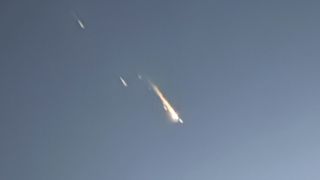
A Chinese satellite has dramatically disintegrated over the U.S. in a mesmerizing "fireball." The spacecraft's fiery demise was visible across several states, footage reveals.
The GaoJing 1-02 commercial imaging satellite was traveling at 17,000 mph (27,400 km/h) when it reentered our atmosphere above New Orleans at 10:08 p.m CST (11.08 p.m. EST on Dec. 21). It then headed north towards Mississippi, Arkansas and Missouri, Jonathan McDowell, an astrophysicist at the Harvard and Smithsonian Center for Astrophysics, wrote on Bluesky.
"The sat has been space junk and dead as a doornail since Jan 2023," McDowell said in response to a comment asking whether the reentry was planned. "This was an uncontrolled reentry."

Related: Boeing-made satellite shatters in orbit, and nobody knows why
The GaoJing 1-02 satellite, or Superview 1-02, launched at the end of 2016, according to NASA. McDowell noted on the social platform X that the satellite was switched off almost two years ago, so it was only a matter of time before it fell back down to Earth.
"Reentry of low orbit sats happen naturally, you have to fire engines to reboost the orbit to avoid it, and this sat was switched off almost 2 years ago," McDowell wrote.
Does anyone know what this is? Seen in Memphis tonight pic.twitter.com/BN6M3dQl5MDecember 22, 2024
As the satellite disintegrated in our atmosphere, social media lit up with a series of photographs and videos of the event, while the American Meteor Society received 120 reports of a "fireball." Some skywatchers mistook the satellite for the Ursid meteor shower, which also peaked over the weekend.
McDowell noted that the satellite was small enough to almost entirely burn up before hitting the ground, and it isn't yet clear whether any pieces survived.
Chinese rocket disintegrated over the Caribbean

The satellite is the second Chinese spacecraft to burn up over North America in recent days. On Friday (Dec. 20), the Astronomical Society of the Caribbean, or Sociedad de Astronomía del Caribe (SAC), filmed a Chinese rocket disintegrating above Puerto Rico.
The Longmarch 4B, or CZ-4B rocket, launched from the Xichang Satellite Launch Center on Aug. 16. The rocket was 145 feet (44 meters) long and took the classified Yaogan-43 satellites to space, before losing altitude over the next four months, Eddie Irizarry, a NASA solar system ambassador and president of the scientific dissemination committee at SAC, reported for EarthSky.
"The rocket body was gradually losing height," Irizarry wrote. "Eventually, atmospheric drag caused it to disintegrate as it reached an altitude of around 70 miles (113 km) over Puerto Rico."


评论(0)